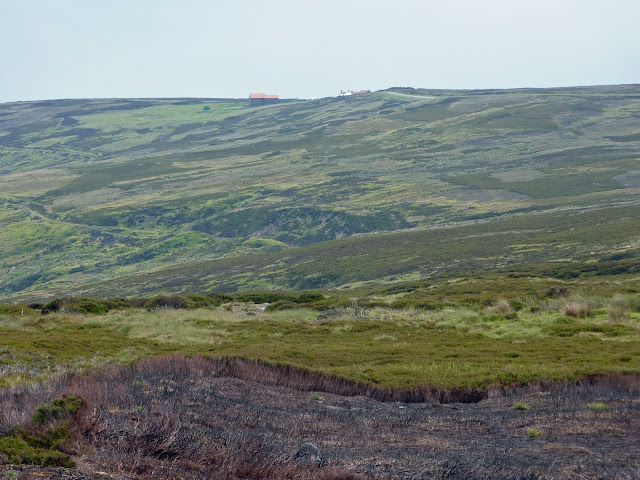Apparently, everyone wanders around a bit in the Greystone Hills. We did no better. The clear trail disintegrated into a dozen possible paths, and signage stopped in the middle of the moor. We used GPS and a compass to get pointed in the right direction, eventually rejoining the trail and nearly stumbling over a signpost which was all of 18 inches high. It was all good for a laugh. Our spirits were high, and we were indomitable. Nothing could stop us now! Once out of the hills we approached Hawsker, a village only half a mile from the North Sea. Here's that joyful moment:
And finally, after a break for Cokes and sandwiches in a mobile home park tea shop, we strode down the grassy slope to the edge of the cliff to view this scene: the eastern coast of England!
What a moment! The wind was blowing hard, seagulls were keening, surf was crashing, and we were grinning like idiots. Turning south, the C2C path followed the coast for several miles before reaching Robin Hood's Bay. Here you can see another headland, with the path skirting the edge of the cliff. There were dramatic views like this around every corner - our reward for all those hours in the clouds and rain earlier this week.
Here's Laura, walking to the sea ...
Finally, we rounded the last headland and got our first glimpse of Robin Hood's Bay. The town has a high sea wall to protect it from cliff erosion, so it looks a bit like a fortress perched on the hill.
The path followed the cliffs until entering town through this gate. From here on, country paths and sheep manure were left behind, to be replaced by tourist shops and ice cream stands. We were ready for a change.

Following C2C tradition, we dipped our boots in the North Sea at RHB, and threw into the sea the pebbles which we had picked up in St. Bees at the start of our walk. We had carried them from coast to coast.
We then strutted past the tourists and joined our fellow walkers in the bar at the Bay Hotel,
where we completed the ritual signing of the C2C book,
and toasted ourselves for a job well done.
18 days, 16 B&Bs, and 31 pints... C2C 2011!

























































